CSX Corp., a major U.S. railroad company, expects coal load volume will drop >10% in 2015; and an additional 9.2% in 2016[1]. Arch Coal, one of the largest domestic coal miners, is likely headed for bankruptcy. Alliance Resource Partners - one of few still-profitable coal miners - issued gloomy guidance last week. Regulation is forcing utilities to switch from coal to natural gas - which is hovering above 10-year lows. The outlook for U.S. businesses dependent on the coal economy is dismal across the board.
However, we believe there is a silver lining at the end of November that could extend miners, railroads and utility companies a lifeline. We also believe this silver lining could potentially be a profitable bet for investors.
Clean Coal Technologies (CCTC) and Leidos, a top U.S. defense contractor and global engineering firm, have built a modular 2 ton/hour test plant capable of dehydrating and stabilizing coal and, potentially, upgrading the most abundant fossil fuel on earth to burn cleaner and more efficiently per ton.
In our estimates we believe that Pristine-M – CCTC’s dehydrating and stabilizing technology – could add $1.5 Billion in annual gross profits to U.S. miners alone[2]. This would be worth as much as $260 Million per year in high-margin royalty revenue to CCTC, which currently trades at a $45 Million valuation.
CCTC Outperforming Broader Coal Economy Ahead of November Catalyst
While coal, utilities and rail companies have traded downwards, CCTC shares have climbed higher, as investors anticipate the results of Pristine-M in ‘upgrading’ coal.
Figure 1: Clean Coal Climbs Higher As Rest of Coal Economy Lags
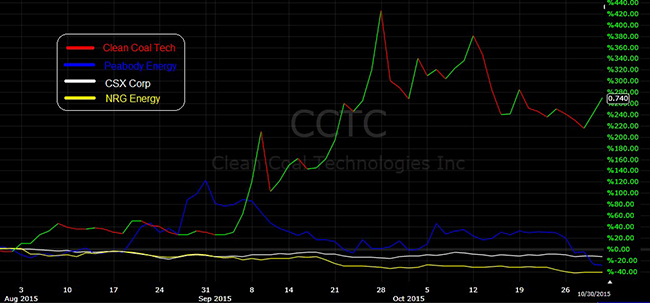
What Does ‘Upgrading’ Mean and Why Is This Important to The U.S. Coal Economy?
Clean Coal’s technology eliminates both the moisture and volatile matter in raw low-ranked coal – also called sub-bituminous - increasing the heat capacity to equivalent levels of higher ranked bituminous coal. Miners can sell upgraded coal (eg. coal that in its raw form was sub-bituminous but upgraded with CCTC’s technology to the equivalent of bituminous) at substantially higher market prices, stimulating sector tied to coal with an economically upgraded product, eg. railroads, utilities, and service names. Removing a substantial percentage of harmful pollutants would also allow the coal industry to withstand some of the environmental scrutiny and enable U.S. coal-fired plants to effectively utilize the abundance of existing low-rank coal for electricity generation.
Figure 2, below, shows how coal’s market share of electricity generation (represented by the blue line) has fallen by 15% in favor of cleaner alternative sources like natural gas (represented by the red line) in the last decade.
Figure 2: 35% of U.S Electricity is Generated from Coal and 31% from Natural Gas
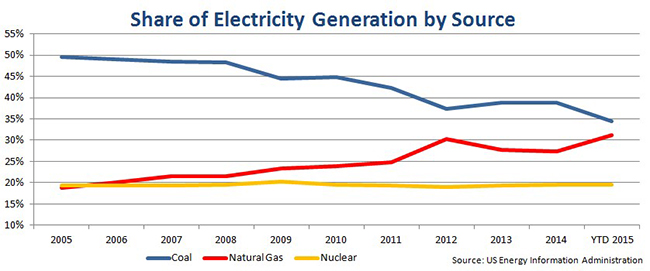
Cheap Natural Gas and Stringent Environmental Regulations Crushing Coal
Abundance of natural gas from fracking has put downward pressure on the price of the commodity, which is flirting with decade lows, as seen in Figure 3, below.
Figure 3: At $2.50/Million BTU, Natural Gas Trading Near Decade Low
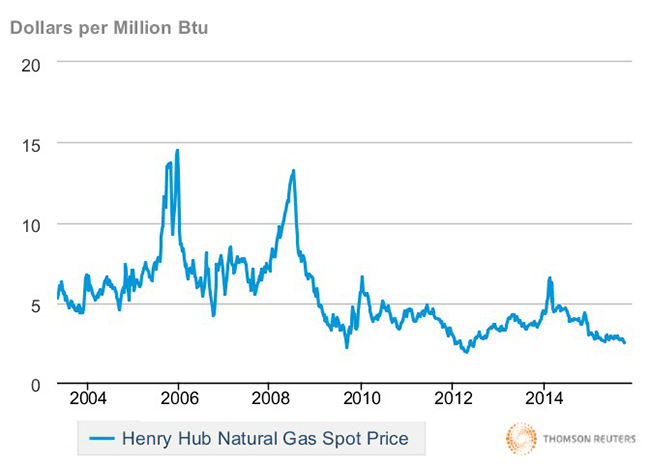
In 2005, less than a fifth of U.S. electricity was generated from natural gas. Today, natural gas accounts for 31%. The Clean Power Plan[3], which comes into effect in 2022, requires that U.S. power plant emissions be 32% lower in 2030 than they were in 2005. This has created challenges for utilities that burn low-grade coal, which is considered a major contributor to greenhouse gas emissions.
Contagion Effect: Coal Struggles Halt Railroads Profits
According to data from the Association of American Railroads[4], 2015 coal carloads have tumbled to three year lows, Figure 4, below, shows.
Figure 4: 2015 Coal Carloads at Lowest Level in 3 Years
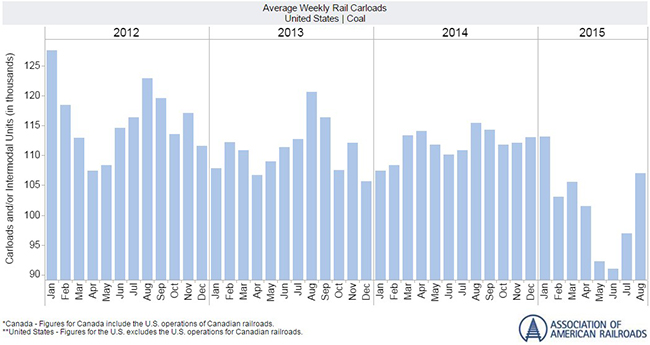
The combination of low natural gas prices and regulatory action has significantly decreased movement of coal domestically. Internationally, slowing economic growth in China and the strengthening of the U.S. dollar has dented Chinese coal imports. Coal is a key commodity for the rail sector - and weakness in demand for coal has been felt by railroad companies on the bottom line. Expectations are for this trend to continue in 2016. Coal’s negative impact on transportation by rail is demonstrated by the three largest companies in the space, figure 5 below.
Figure 5: Year-Over-Year Coal Shipments Down Double Digits In Q3 2015

Coal accounts for roughly 9% of rail traffic[5], however exposure could mount to losses in the hundred of millions if a solution to the coal problem is not found. We think CCTC could have a potential solution and by extension help rail traffic in the U.S. if Pristine-M lives up to management expectations.
Pristine-M Could Be Worth Billions to the U.S. Economy, And Then Some - Abroad
Globally, coal dominates the energy grid. The infrastructure needed to completely wean the world’s dependence off of coal is trillions of dollars and thought to be generations away. Natural gas is hovering near decade lows, but even its biggest supporters admit a lack of infrastructure will limit the amount of energy share it takes from coal[6].
Therefore, emerging nations will inevitably continue to rely on coal to power their growing electricity needs. Figure 6, below, shows the breakdown of coal used to generate electricity by country.
Figure 6. Share of Electricity Generated By Burning Coal, By Country

Clean Coal Technologies is expected to release independent results of a commercial-scale coal upgrading test plant using Pristine-M by the end of November. If successful, the plant, which was designed by Leidos - one of the largest and most respected engineering firms in the world - could give U.S. coal miners a fighting chance to compete with cleaner energy sources like natural gas.
Pristine-M is a coal dehydration technology that removes moisture and stabilizes the ‘upgraded’ coal - which minimizes the production of gas or liquid byproducts, eg. greenhouse gases[7]. Stabilized coal makes the commodity impermeable and easy to transport with low risk of spontaneous combustion. The most novel aspect of Pristine-M is related to the stabilization of the end product and ability to enhance heat content beyond what would normally be achieved by moisture removal alone. Pristine-M is designed to make low-grade coal cleaner and more effective as an energy source.
Below, in Figure 5, we show an economic comparison of low-grade U.S. coal to coal that is upgraded using Pristine-M, CCTC’s dehydration and stabilization technology.
Figure 7: Pristine-M Adds ~$11.50/Ton of Gross Margin To Low-Grade Coal
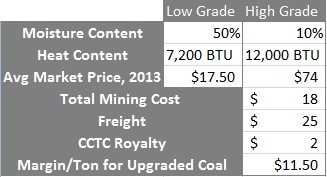
Based on estimates from the Company[8], we ran with an assumption that Pristine-M reduces the moisture content of coal mined by the likes of Arch Coal and Peabody 40%. Regulatory pressures and a decline in the price of competing fuels have brought coal production to decade lows[9]. Even at depressed production levels, CCTC’s technology could generate $1.5B in annual gross profit for US coal miners (we break down the calculation here). The top 3 US coal miners had cumulative gross profits of $1.7B in the last 12 months, for reference.
For the Risk-Tolerant Investor, Upside in CCTC Could Be Extraordinary
If Clean Coal Technologies was able to capture a $2/ton royalty on 130M tons of low-grade coal currently mined in the U.S., and valued at 1x sales, CCTC shares would be worth roughly 6X current market price. The extraordinary upside is not without risk: (i) the Company reported that it would need an additional $5-7 Million for fiscal 2016 and this would cause dilution for current shareholders, (ii) Pristine-M could fail to upgrade coal economically, (iii) even if Pristine-M effectively upgrades coal, uptake of the technology could be adversely affected by uncontrollable factors such as regulations, the global economy and so forth.
According to CCTC management, the Company has taken steps to mitigating some of these risks, including early and later-stage discussions with licensees and partners in the U.S. and abroad. This focus suggests management is confident that the modular design of Pristine-M plant, previous coal studies, and operating cost estimates prepared by Leidos will attract clients, as early as this year.
We would also point to White Energy, an Australian company whose technology once held promise in upgrading coal. At its peak, White Energy was valued at $800M+, compared to $45 Million for CCTC. White Energy failed to deliver on its promise because of unsustainable costs. Comparably speaking, CCTC believes their technology is the only economically-viable clean coal technology currently being validated. For instance, Jindal Power & Steel is an early licensee of Pristine-M, which, in our view, is validating of Pristine-M and its cost structure. Jindal is India’s 3rd-largest steel producer and coal miner.
For investors in coal, utilities, and rail companies, CCTC’s anticipated test-plant results at the end of November could be a silver lining and, potentially, a compelling way to hedge risk and capture extraordinary upside.
References
1) http://www.platts.com/latest-news/coal/houston/csx-expects-us-domestic-coal-volumes-to-decline-26241618
2) http://ir.baystreet.ca/article.aspx?id=160&1441715178
3) http://www.vox.com/2015/8/4/9096903/clean-power-plan-explained
4) https://www.aar.org/Pages/Freight-Rail-Traffic-Data.aspx
5) https://www.aar.org/Pages/Freight-Rail-Traffic-Data.aspx
6) http://www.bloomberg.com/news/articles/2015-09-01/coal-s-worst-days-have-passed-as-archaic-grid-crimps-gas-growth
7) http://www.otcmarkets.com/edgar/GetFilingHtml?FilingID=10972006
8) http://content.stockpr.com/cleancoaltechnologiesinc/db/Presentations/383/pdf/CCTC+Corporate+Presentation+Q2+2015.pdf
9) http://www.bp.com/content/dam/bp/pdf/energy-economics/statistical-review-2015/bp-statistical-review-of-world-energy-2015-full-report.pdf
About One Equity Research
One Equity Research is a leading provider of proprietary and in-depth research crafted by respected financial analysts and domain experts. Our team includes trained finance professionals with diverse backgrounds that include equity research, investment banking, and strategic consulting at preeminent firms. We distribute our research through mainstream media partners and to subscribers of our Intelligence Service. To learn more please visit http://www.oneequityresearch.com/
Legal Disclaimer: This research note has been prepared by One Equity Research LLC ("One Equity") on behalf of Clean Coal Technologies, Inc. (the "Company") as part of research coverage services. One Equity has received five hundred fifty restricted shares as consideration as of the date of this note and expects to be issued an additional five hundred fifty thousand restricted shares during the course of research coverage. One Equity intends to sell its shares in the Company as soon as it is legally permissible to do so. An affiliate of One Equity is long shares of Clean Coal Technologies and will sell their position at any time without providing written notice. This note is for information purposes only, and is not intended to (and is provided explicitly on the condition that it not) be used as a basis to make any investment decisions. Investing involves considerable risk. One Equity urges all readers to carefully review the Company’s SEC filings and consult with an investment professional before making any investment decisions. Investors should make their own determinations whether an investment in any particular security is consistent with their investment objectives, risk tolerance, and financial situation. Please read our full disclaimer at http://www.oneequityresearch.com/terms/